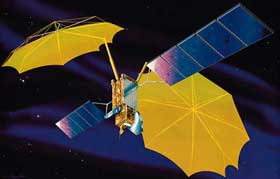Garuda

Garuda 1.
The Garuda satellites were intended to provide global support for mobile telephone communications users in Asia; "Garuda" is Sanskrit for "eagle."
Launched by a Proton rocket on 13 February 2000, from Baikonur, Garuda-1 was the first satellite of a planned constellation that comprises the ACeS (Asia System Cellular Satellite) system. ACeS began in 1995 as a joint venture between three large Asian communications companies: Pacific Satelit Nusantara (PSN) of Indonesia, the Philippine Long Distance Telephone Company (PLDT) and Jasmine International Overseas of Thailand. In December 1998, a wholly owned subsidiary of Lockheed Martin, called Global Telecommunications, also joined the venture. Not coincidentally, Lockheed Martin built the Garuda spacecraft, based on its large A 2100 bus. The second ACeS satellite, Garuda-2, was to have served first as a backup to Garuda-1 and then to allow the ACeS system to expand coverage to western and central Asia, the Middle East, Europe and northern Africa. The In the event, Garuda 2 was never built.
Garuda-1 was equipped with giant 15-meter (49-feet) umbrella-like L-band antennas, which dwarfed the antennas of previous commercial satellites – usually not larger than 4.5 meters (14.8 feet). They allowed it to transmit 16,000 phone calls simultaneously, within 140 spot beams, from a geostationary orbit 36,000 kilometers (22,370 miles) over the equator. The spacecraft's control center was located on Batam Island, Indonesia.


